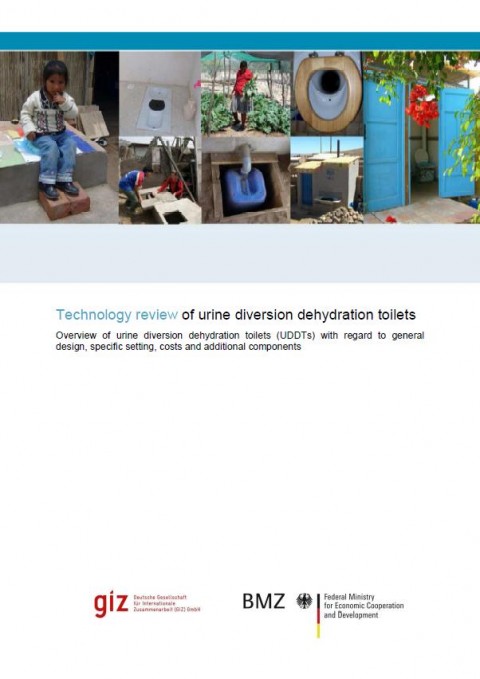Technology review of urine-diverting dry toilets (UDDTs) - Overview on design, management, maintenance and costs
Rieck, C., von Münch, E., Hoffmann, H. (2012)

Published in: 2012
Publisher:
Deutsche Gesellschaft fuer Internationale Zusammenarbeit (GIZ) GmbH, Eschborn, Germany
Author:
Rieck, C., von Münch, E., Hoffmann, H.
Uploaded by:
SuSanA secretariat
Partner profile:
Deutsche Gesellschaft für Internationale Zusammenarbeit (GIZ) GmbH
30484 Views
3023 Downloads
Content - Summary
This technology review deals with a type of toilet designed specifically for dry excreta management called the urine-diverting dry toilet (UDDT). It is a sanitation system for households and public facilities as well. The functional design elements of the UDDT are: source separation of urine and faeces; waterless operation; and ventilated vaults or containers for faeces storage and treatment. UDDTs may be constructed with two adjacent dehydration vaults or one single vault with interchangeable containers.
This publication offers a complete overview of UDDT functions, design considerations, common operation and maintenance issues and generalised installation costs. Its focus is on applications in developing countries and countries in transition, although UDDTs are also applicable in developed countries.
The UDDT technology was originally promoted in connection with safe reuse of excreta. However, the primary focus of UDDT implementation has gradually shifted from that of excreta reuse to the broader objective of creating an odourless, dry and versatile toilet that is applicable across wide range of geographic and economic contexts. Many successful examples of large-scale UDDT programmes, such as those found in Lima, Peru and eThekwini (Durban), South Africa, dispose of treated excreta instead of reusing it, as it is considered more practical, convenient or acceptable to the users.
The primary advantage of UDDTs, as compared to conventional dry latrines like ventilated improved pits (VIP) latrines, is the conversion of faeces into a dry and odourless material. This leads to an odour and insect free toilet which is appreciated by users and to the simple removal and less offensive and safer handling of the faecal material once the toilet has filled up. Moreover the risk of water pollution is minimised through the safe containment of faces in aboveground vaults which also allows the toilets to be constructed in locations where pit-based systems are not appropriate. The faeces are however not entirely sanitised when removed from the toilet, so precautious handling is obligatory. In scenarios with reuse of excreta in agriculture, a post-treatment of faecal matter and storage of urine is advisable to ensure adequate sanitisation.
This publication provides comprehensive design guidelines for all functional UDDT components, including urine diversion (UD) pedestals, benches and squatting pans, dehydration vaults, single vaults with interchangeable containers, and urine piping and storage systems. Possible design modifications are discussed to ensure the toilet’s suitability for small children, the elderly and persons with disabilities. Additionally, all relevant aspects of excreta management are described including treatment, disposal, reuse and maintaining hygienic quality standards.
Emphasis is placed on recent technical innovations that allow the UDDT to be integrated in a wider range of applications. The bench design, a sitting type of UD interface that minimises the need for stairs leading up to the toilet, is presented as a possible solution for indoor installations and means of providing barrier-free access. Other designs are presented for a variety of contexts, including indoor and outdoor installations, schools and public toilet blocks, flood prone areas and floating villages.
This technology review also describes common O&M problems, such as blockages in urine piping systems, wet conditions in the dehydration vaults and faulty construction. Possible fixes and preventative maintenance routines are emphasised as a means of ensuring the toilet’s sustainability.
This publication challenges the common perception that UDDT installation costs are prohibitive for the poorest members of society. A number of low-cost UDDT designs are available that take advantage of locally available construction materials and can help tailor the toilet technology to available budgets.
+++++++++++++
If you wish to provide feedback or comments please get in touch with us (sanitation@giz.de) or use the discussion forum here:
http://forum.susana.org/forum/categories/34-urine-diversion-systems-includes-uddt-and-ud-flush-toilet/3688-new-qtechnology-review-of-uddtsq-by-giz-now-published.
Hardcopies are available on request (send an e-mail to sanitation@giz.de).
Note: Last updated 18 June 2013
Bibliographic information
Rieck, C., von Münch, E., Hoffmann, H. (2012). Technology review of urine-diverting dry toilets (UDDTs) - Overview on design, management, maintenance and costs. Deutsche Gesellschaft fuer Internationale Zusammenarbeit (GIZ) GmbH, Eschborn, Germany
Filter tags
English Faeces or faecal sludge Practitioners Recommended by SuSanA (other than SuSanA publications) Urine Urine diversion dehydration toilets (UDDTs)















